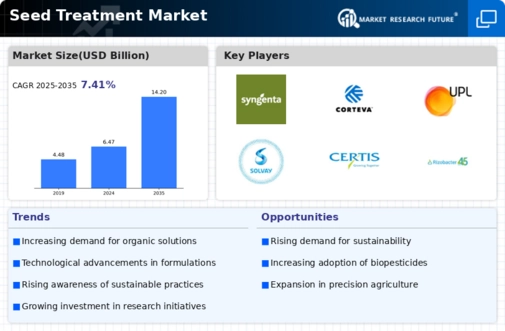Market Trends
Key Emerging Trends in the Seed Treatment Market
To compete, seed treatment companies utilize numerous market share positioning methods. Protective chemicals are applied to seeds before planting to improve crop yield and avoid pests.
Technical innovation is a Seed Treatment Market strategy. To improve seed treatments, companies invest much on R&D. This requires innovative active ingredients, delivery methods, and eco-friendly solutions. Staying ahead of technology may help companies stand out and attract farmers seeking innovative seed treatments.
Companies develop custom seed treatment regimens for farmers and crops. Disease and insect protection varies by crop and location. By offering farmers customized seed treatments, companies may become comprehensive seed treatment providers. Customization helps companies target specific markets and gain an edge.
Geographical expansion is essential for Seed Treatment Market players seeking growth. To succeed, seed treatment formulae must fit climate, soil, and farming. Companies with many sites may attract farmers and wholesalers. Product adaptation, distribution network growth, and agricultural collaboration are part of this approach.
Successful market share positioning needs partnership with research institutions, universities, and agricultural extension organizations. Company partnerships with specialists yield insights, new technologies, and research. Collaboration often creates new seed treatments. Through joint marketing, partnerships may help firms grow and gain reputation.
As sustainable agriculture gains popularity, Seed Treatment Market companies are stressing their goods' environmental advantages. Develop seed treatments that reduce environmental impact, chemical residues, and promote sustainable farming. Meeting growing demand for eco-friendly products may attract environmentally conscious farmers and increase market position.
Education and training are effective market share positioning strategies. Companies teach farmers about seed care through workshops, field demonstrations, and training. By informing farmers about seed treatment benefits, corporations may influence purchases and build loyalty. Market share positioning requires strong branding and marketing. Companies build brands around seed treatment product reliability and efficacy. Marketing uses testimonies, case studies, and data to explain how seed treatment increases crop yields. Customer retention requires a positive brand image.
Cereals & grains, oilseeds & pulses, fruits & vegetables, etc. divide the global seed treatment market. Due to wireworms on cereal and grain seeds, this group dominates the market. In early development, seed treatment maximizes kernel potential. This treatment controls soil-borne fungus and stabilizes crops.
Pelleting canola seeds by Syngenta may decrease planting errors like missing or double- or triple-hits. In early May, Syngenta Canada debuted Pelta, a seed pelleting technology that optimizes seed quality to increase singulation planter performance. Syngenta says its Pelta-based canola-seeding technology will reduce expensive planting mistakes in a recent press release. The Pelta coating promotes bag-wide seed uniformity."












Leave a Comment